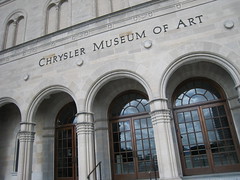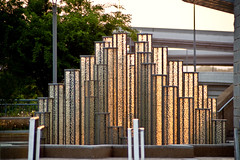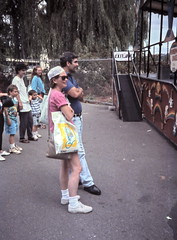Photo Credit: Flickr user Ohdearbarb
CC licensed
Virginia has been added to the glassblower's circuit which now includes the Toledo Art Musuem, the Corning Museum of Glass, and The Museum of Glass in Tacoma. I think glass art is officially revived here, let's hope something very good comes of all the resources being allocated to it.
Chrysler Museum of Art Press Release:
"NORFOLK, Va. – (October 22, 2010) – The Chrysler Museum of Art announced today it will open the Chrysler Museum Glass Studio in 2011 to complement the world-class glass collection in the Museum. The addition of the Glass Studio enhances the Museum’s stature as one of the top three museums in the United States with an art glass focus.
Construction has started on creating the Chrysler Museum Glass Studio in the 7,000-square-foot building that sits across the street from the Museum on the corner of Duke and Grace Streets in Norfolk.
The project budget is $7.5 million, which includes an endowment for operating expenses, two new full-time jobs and several part-time jobs.
The reality of the Chrysler Museum Glass Studio was sparked from the interest and support base demonstrated during Art of Glass 2. The region’s blockbuster glass exhibition in 2009 featured the Chrysler Museum, Virginia Arts Festival and the Contemporary Art Center of Virginia as major partners, with 21 regional affiliates throughout Hampton Roads.
“We had high hopes for Art of Glass and Art of Glass 2 to position Hampton Roads as the East Coast glass center,” says Andrew Fine, Art of Glass 2 chairman and Chrysler Museum trustee. “The Art of Glass exhibitions exceeded all expectations in terms of visitors who came to see the world-class spectacle. Now, the vision to transform Hampton Roads into a major glass center is becoming a reality with this studio that will complement the Chrysler’s brilliant glass collection.”
“The Glass Studio will allow our visitors to experience glassmaking and be involved in every step of the process,” says Bill Hennessey, the Museum’s director. “We anticipate this will draw people to the region to learn about glass, meet visiting glass artists and tour our collection. We expect this to be a significant educational component for the region—one that will allow us to further strengthen our partnerships with groups such as Tidewater Community College and the Governor’s School for the Arts. With more than a third of our 35,000-object collection devoted to glass, this is clearly a strong suit for the Chrysler. This Glass Studio will bring these works of art to life.”
“The Glass Studio will help our visitors gain a better understanding and appreciation for the wonderful objects in our collection,” says Kelly Conway, curator of glass. “We devote a lot of time explaining the technical processes used to make these artworks. The studio will provide far more capable and lively answers for these technique-based questions from our visitors, and tours will connect the live studio experience with the contextual history explained in the glass galleries.”
“We are using the nation’s foremost designer and fabricator of glass studio equipment,” says Scott Howe, education director and project manager for the studio. “The state-of-the-art facility will be able to accommodate both aspiring and master glass artists with furnaces, annealing ovens and a flameworking table.
We will also have an artist-in-residency program that will attract some of the leading artists in contemporary glass. From an educational perspective, this will greatly enhance our programs to engage people with art. During Art of Glass 2, mobile hot-shops gave guests a small glimpse of what glassblowing entails. This Glass Studio will be on a level that is unmatched.”
Construction will continue through 2011, and it is anticipated the Chrysler Museum Glass Studio will open to the public next fall. Visitors will be able to enjoy free glassmaking demonstrations, and the Museum will offer a series of classes and workshops for students and adults. These will include a range of educational programs from beginners to master classes for accomplished professional artists.
"
Chrysler Museum of Art. Press Release. "Chrysler Museum to open $7.5-million glass studio." October 22, 2010. Accessed October 31, 2010. http://www.chrysler.org/glass-studio.asp

















.JPG)






